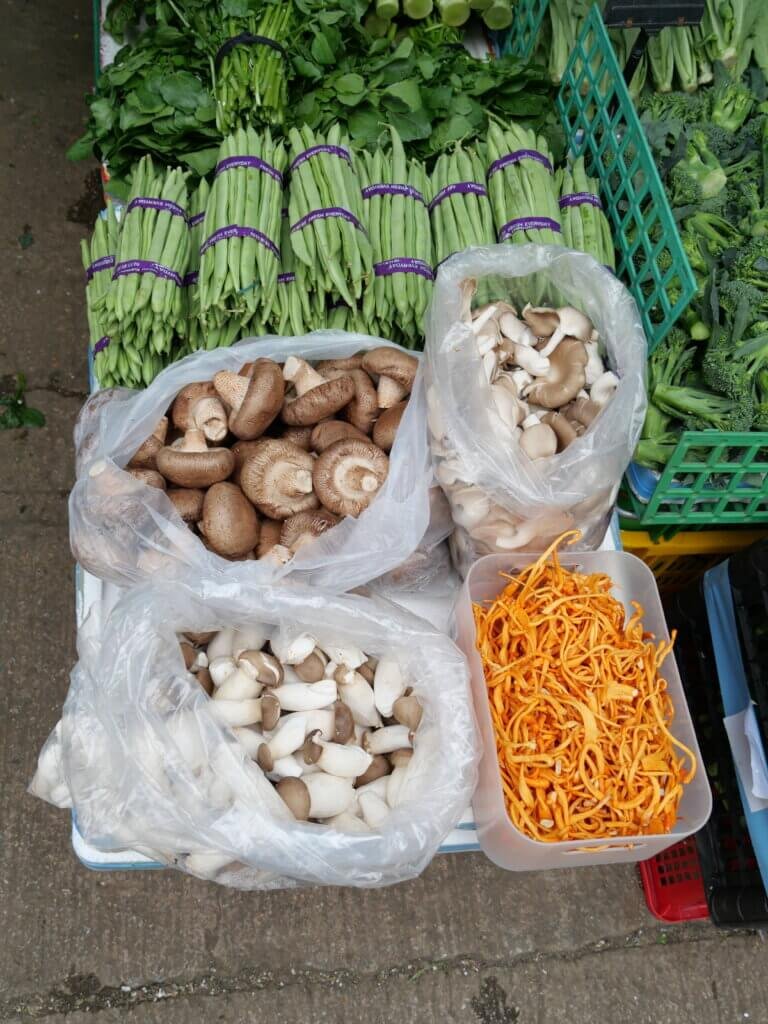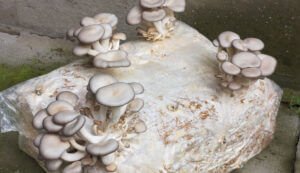Oyster mushrooms (Pleurotus ostreatus) are a type of edible mushroom that grow wild in forests and on logs, as well as being cultivated commercially. They are one of the most widely consumed mushrooms in the world due to their delicious taste and nutritional value.

History of Oyster Mushrooms
Oyster mushrooms (Pleurotus ostreatus) have been consumed for thousands of years in Asia, particularly in China, Japan, and Korea, where they are known as “tree mushrooms.” They were first cultivated by the Chinese during the Tang dynasty (618-907 AD), and then spread to Japan and Korea in the 16th century, they were believed to have immune-boosting properties and were used to treat a range of ailments.
In 1936, Japanese scientist Dr. Takashi Watanabe discovered a way to cultivate oyster mushrooms using sawdust as a substrate. This method was later improved upon in the 1950s by Dr. Eiji Yasuhara, who developed a more efficient way to cultivate oyster mushrooms on a commercial scale.
In the West, oyster mushrooms were not commonly consumed until the 20th century, when they were introduced to Europe and North America. The first commercial cultivation of oyster mushrooms in the United States was established in the early 1970s in Pennsylvania, and the industry has since expanded to other regions.

Today, oyster mushrooms are widely cultivated and consumed around the world and are prized for their nutritional value and culinary versatility. They are also being studied for their potential medicinal properties, including their ability to stimulate the immune system and fight infections.
Nutrients and Health Benefits of Oyster Mushrooms

Oyster mushrooms are a nutritious and healthy food source that offers numerous health benefits. Here are some of the key nutrients found in oyster mushrooms and their associated health benefits:
Protein: Oyster mushrooms are a good source of protein. The exact amount of protein can vary depending on the specific type of oyster mushroom, but on average, they contain around 2-3 grams of protein per 100 grams (about 3.53 oz). This makes them a good low-calorie and low-fat protein source for vegetarians and vegans.
Fiber: Fiber is essential for maintaining good digestive health and preventing constipation. Oyster mushrooms are a good source of fiber, which can help you feel fuller for longer and promote healthy digestion.

Vitamins and minerals: Oyster mushrooms are a good source of several vitamins and minerals, including:
- Vitamin D: Oyster mushrooms are one of the few natural sources of vitamin D, which is essential for bone health, immune function, and many other bodily processes.
- B vitamins: Oyster mushrooms contain several B vitamins, including niacin, riboflavin, and pantothenic acid, which are important for energy metabolism and brain function.
- Iron: Oyster mushrooms are a good source of iron, which is needed for the production of red blood cells and oxygen transport in the body.
- Potassium: Oyster mushrooms contain potassium, which is important for maintaining healthy blood pressure, nerve function, and muscle contraction.
- Zinc: Oyster mushrooms are a good source of zinc, which is important for immune function, wound healing, and DNA synthesis.
Antioxidants: Oyster mushrooms, contain various antioxidant compounds that are beneficial for human health. Antioxidants help protect cells from damage caused by free radicals, which are harmful molecules that can cause cell damage and contribute to the development of diseases such as cancer, heart disease, and Alzheimer’s disease.
Some of the antioxidants found in oyster mushrooms include:
- Ergothioneine: This is a unique antioxidant found only in mushrooms and some bacteria. Ergothioneine has been found to have anti-inflammatory and neuroprotective properties.
- Glutathione: This is a powerful antioxidant that helps protect cells from damage caused by free radicals, toxins, and other harmful substances.
- Polysaccharides: Oyster mushrooms contain polysaccharides, which are complex carbohydrates that have antioxidant properties. These compounds have been shown to have immune-boosting properties and may also help lower inflammation in the body.
- Phenols: Oyster mushrooms contain various phenolic compounds, which are plant-based antioxidants that can help reduce oxidative stress and inflammation in the body.
Calories: Oyster mushrooms are low in calories and can be a great addition to a healthy diet. One cup (86 grams) of raw oyster mushrooms contains:
- Calories: 28
- Protein: 3 grams
- Fat: 0.3 grams
- Carbohydrates: 5 grams
- Fiber: 2 grams
- Sugar: 1.5 grams
Compared to other mushrooms, oyster mushrooms have a lower calorie count and contain more protein and fiber. This makes them a filling and nutritious addition to salads, stir-fries, and soups. Additionally, oyster mushrooms are a good source of potassium, which can help regulate blood pressure and maintain healthy heart function.
Oyster Mushroom Varieties
Oyster mushrooms are one of the most popular and easy-to-grow edible mushrooms. They come in a variety of colors and flavors, and each type has its own unique characteristics. Here are some of the most common oyster mushroom varieties:
 Pleurotus ostreatus (Grey oyster mushroom): This is the most common and widely cultivated oyster mushroom. It has a meaty texture and a mild, nutty flavor.
Pleurotus ostreatus (Grey oyster mushroom): This is the most common and widely cultivated oyster mushroom. It has a meaty texture and a mild, nutty flavor.
 Pleurotus pulmonarius (Phoenix oyster mushroom): This type of oyster mushroom has a delicate texture and a sweeter taste than the grey oyster mushroom.
Pleurotus pulmonarius (Phoenix oyster mushroom): This type of oyster mushroom has a delicate texture and a sweeter taste than the grey oyster mushroom.
 Pleurotus cornucopiae (Black oyster mushroom): This mushroom has a distinctive funnel shape and a dark brown or black cap. It has a mildly sweet and nutty flavor.
Pleurotus cornucopiae (Black oyster mushroom): This mushroom has a distinctive funnel shape and a dark brown or black cap. It has a mildly sweet and nutty flavor.
 Pleurotus eryngii (King oyster mushroom): This oyster mushroom has a thick, meaty stem and a small cap. It has a delicate, slightly sweet flavor.
Pleurotus eryngii (King oyster mushroom): This oyster mushroom has a thick, meaty stem and a small cap. It has a delicate, slightly sweet flavor.
 Pleurotus citrinopileatus (Golden oyster mushroom): This mushroom is named for its golden yellow color. It has a mild, fruity flavor and a slightly nutty aroma.
Pleurotus citrinopileatus (Golden oyster mushroom): This mushroom is named for its golden yellow color. It has a mild, fruity flavor and a slightly nutty aroma.
 Pleurotus florida (Pink oyster mushroom): This mushroom has a striking pink color and a delicate flavor with hints of anise and almond.
Pleurotus florida (Pink oyster mushroom): This mushroom has a striking pink color and a delicate flavor with hints of anise and almond.
 Pleurotus nebrodensis (Nebrodensis oyster mushroom): This mushroom is a rare and expensive variety that is native to Italy. It has a meaty texture and a delicate flavor that is slightly sweet and nutty.
Pleurotus nebrodensis (Nebrodensis oyster mushroom): This mushroom is a rare and expensive variety that is native to Italy. It has a meaty texture and a delicate flavor that is slightly sweet and nutty.
All of these oyster mushroom varieties are relatively easy to grow at home, and each one offers a unique taste and texture that can add variety to your meals.
Oyster mushroom farming grows oysters for commerce.
Oyster mushroom farming is becoming increasingly popular among home gardeners because it is easy to grow and provides a significant yield. Here are some steps to get started with oyster mushroom farming at home:
Choose a growing medium: Oyster mushrooms can be grown on a variety of substrates, such as straw, sawdust, coffee grounds, or even old books. The growing medium should be sterilized by boiling, microwaving, or baking to kill any bacteria or fungi that may be present.

Inoculate the substrate: Once the growing medium has cooled down, it is time to inoculate with oyster mushroom spawn. The spawn is a live culture of mycelium (the vegetative part of the fungus) that will gradually colonize the substrate and eventually produce mushrooms. To inoculate, mix the spawn with the substrate and pack it into a container or bag with air holes.

Provide proper growing conditions: Oyster mushrooms prefer a warm, humid environment with good air circulation and moderate light. Keep the growing container in a dark, warm room and mist the surface regularly to maintain humidity. The mycelium will begin to grow within a week or two, and you should see the first mushrooms forming after about three weeks.

Harvest the mushrooms: Once the mushrooms have reached their desired size (usually around 2-3 inches), gently twist and pull them off the substrate. The mushrooms will continue to grow until the substrate is exhausted, producing new flushes every few weeks. When all the mushrooms have been harvested, the substrate can be composted or used as mulch.


Impact of Oyster Mushroom Cultivation on Environment.
Oyster mushroom cultivation is a sustainable and eco-friendly practice that promotes environmental health. Unlike traditional farming practices that rely on chemical fertilizers and pesticides, oyster mushroom farming relies on natural resources such as agricultural byproducts, sawdust, and other organic matter.
One of the most significant environmental benefits of oyster mushroom cultivation is that it generates very little waste. The substrate and mushroom stems can be reused as compost or animal feed, eliminating the need for disposal and reducing the amount of biodegradable waste that ends up in landfills.
In addition, oyster mushroom cultivation has a minimal carbon footprint, as it requires minimal energy and resources to produce. Unlike conventional agriculture, which requires the use of heavy machinery and fossil fuels, oyster mushroom farming relies on natural methods that have little impact on the environment.
Furthermore, oyster mushrooms have been found to have a symbiotic relationship with plants and can help improve soil quality and increase the fertility of the soil. This makes it an ideal crop for farmers seeking to improve the productivity of their land while minimizing environmental damage.
Cooking with Oyster Mushroom
Oyster mushrooms are a versatile and delicious ingredient that can be used in a variety of recipes. Here are some tips and recipes for cooking with oyster mushrooms:

Choose fresh oyster mushrooms that are firm and dry. Avoid mushrooms that have a slimy or mushy texture.
Clean the mushrooms by wiping them with a damp cloth. Avoid washing the mushrooms under running water as they can absorb too much moisture.
Oyster mushrooms can be cooked in a variety of ways including sautéing, roasting, grilling, and frying. They can also be used raw in salads.
Oyster mushrooms have a delicate flavor that pairs well with garlic, thyme, rosemary, and other aromatic herbs.
Recipes and Tips for Delicious Meals
Garlic Butter Oyster Mushrooms

To ensure that the mushrooms cook uniformly after they have been gathered (or purchased), chop them into equal-sized pieces.
Two tablespoons of olive oil are heated to medium-high heat in a large, heavy pan. 
The mushrooms should be spread out evenly and let to cook for 3-5 minutes until they begin to brown.
Stir the mushrooms and cook for an additional 3 to 5 minutes, or until they are evenly browned.
Reduce the heat to medium-low and add two tablespoons of grass-fed butter or ghee, a few crushed garlic cloves, and a few thyme sprigs to the pan.
Butter the mushrooms and continue cooking for a further 5 minutes, or until they are almost crispy and dark brown. To taste, add salt and pepper to the food.

Oyster mushroom with broccoli
Of course, the most delicious and useful dishes of oyster mushrooms
For example, it can work as a sandwich or as a main dish with a tumi.
- 3 tbsp butter
- Broccoli
- Intermittent oyster mushroom
- 3 garlic cloves
- Babrika Spoon
- Pepper or slash to taste




